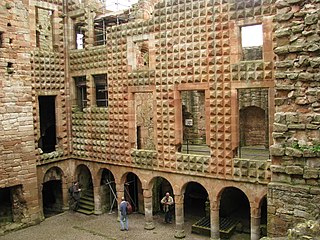Related Research Articles

Ludovic Stewart, 2nd Duke of Lennox and 1st Duke of Richmond, Seigneur d'Aubigny in France, lord of the Manor of Cobham, Kent, was a Scottish nobleman who through their paternal lines was a second cousin of King James VI of Scotland and I of England. He was involved in the Plantation of Ulster in Ireland and the colonization of Maine in New England. Richmond's Island and Cape Richmond as well as Richmond, Maine, are named after him. His magnificent monument with effigies survives in Westminster Abbey.

George Home, 1st Earl of Dunbar, KG, PC was, in the last decade of his life, the most prominent and most influential Scotsman in England. His work lay in the King's Household and in the control of the State Affairs of Scotland and he was the King's chief Scottish advisor. With the full backing and trust of King James he travelled regularly from London to Edinburgh via Berwick-upon-Tweed.

Francis Stewart, 5th Earl of Bothwell was Commendator of Kelso Abbey and Coldingham Priory, a Privy Counsellor and Lord High Admiral of Scotland. He was a notorious conspirator, who led several uprisings against King James VI and died in poverty, in Italy, after being banished from Scotland. Francis was the first cousin of King James VI of Scotland. Francis's maternal uncle James Hepburn, 4th Earl of Bothwell was the chief suspect in the murder of James VI's father Henry Stuart, Lord Darnley.
Patrick Gray, 6th Lord Gray, known most of his life as Patrick, Master of Gray, was a Scottish nobleman and politician during the reigns of Mary, Queen of Scots and James VI of Scotland.

George Seton V, 7th Lord Seton (1531–1586), was a Lord of the Parliament of Scotland, Master of the Household of Mary, Queen of Scots, and Provost of Edinburgh. He was the eldest son of George Seton, 6th Lord Seton, and Elizabeth Hay, a daughter of John Hay, 3rd Lord Hay of Yester. His childhood and schooling were in France.
Sir David Foulis was a Scottish politician.
Sir Richard Cockburn of Clerkington, Lord Clerkintoun (1565–1627) was a senior government official in Scotland serving as Lord Privy Seal of Scotland during the reign of James VI.

Thomas Fowler was an English lawyer, diplomat, courtier, spy, servant of the Countess of Lennox, broker of the marriage of Mary, Queen of Scots and Lord Darnley, steward of the Earl of Leicester, advisor to James VI of Scotland and the Scottish ambassador in London, Archibald Douglas.
Sir Roger Aston of Cranford, Middlesex, was an English courtier and favourite of James VI of Scotland.
Robert Melville, 1st Lord Melville was a Scottish diplomat, administrator, jurist, and intriguer, and uncle of the poet Elizabeth Melville.

John Wemyss younger of Logie, (1569-1596), was a Scottish courtier, spy, and subject of the ballad "The Laird o Logie", beheaded for plotting to blow up a fortification at Veere in the Netherlands

John Murray, 1st Earl of Tullibardine was a Scottish courtier and leader of the Clan Murray.
Barbara Ruthven was a Scottish courtier and favourite of Anne of Denmark, expelled from court after the death of her brother.

William Dundas of Fingask, was a Scottish courtier who wrote newsletters.
Sir James Sandilands was a courtier to King James VI and I and captain of Blackness Castle
Richard Douglas was a Scottish landowner, courtier, and letter writer.
George Nicholson or Nicolson, was an English diplomat in Scotland.
Andrew Melville of Garvock was a Scottish courtier and servant of Mary, Queen of Scots.
George More was an English Catholic exiled in the Spanish Netherlands. He visited the royal court of Scotland in 1598.

Nicholas Williamson was an English lawyer and Catholic recusant in the 1590s. He was arrested in 1595 after planning a visit to the court of James VI of Scotland. The Jesuit William Crichton had hoped that Williamson would encourage the ambition of James VI for the throne of England.
References
- ↑ John Spottiswood, History of the Church of Scotland, vol. 2 (Edinburgh, 1851), p. 448, 454: Alan McDonald, The Jacobean Kirk, 1567-1625 (Farnham, 1998), p.56.
- ↑ Calendar of the Manuscripts of the Marqess of Salisbury at Hatfield, vol. 4 (London, 1892), p. 600.
- ↑ Keith Sprunger, Dutch Puritanism (Leiden, 1982), 294-5, 262.
- ↑ Alexandra Gadja, The Earl of Essex and Late Elizabethan Political Culture (Oxford, 2012), p. 186: R. B. Wernham, List and Analysis of State Papers (London, 2000), p. 117.
- ↑ Calendar of State Papers Scotland, vol. 13 part 1 (Edinburgh, 1969), p. 230, 458.
- ↑ Calendar of State Papers Scotland, vol. 13 part 1 (Edinburgh, 1969), pp. 335-6.
- ↑ Calendar of the Manuscripts of the Marquess of Salisbury at Hatfield, vol. 9 (London, 1902), 319.